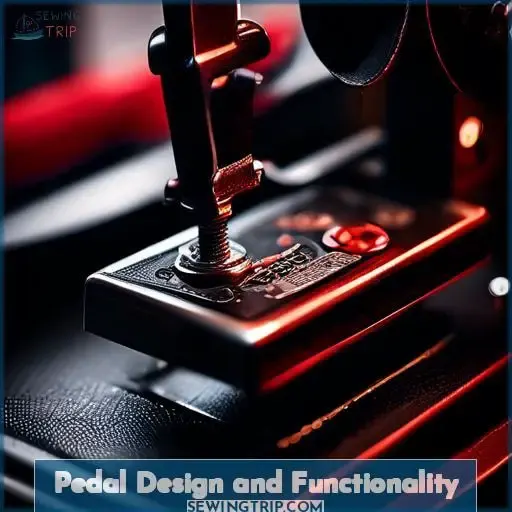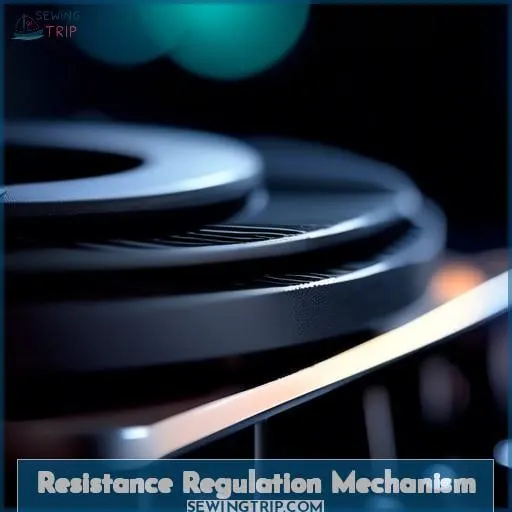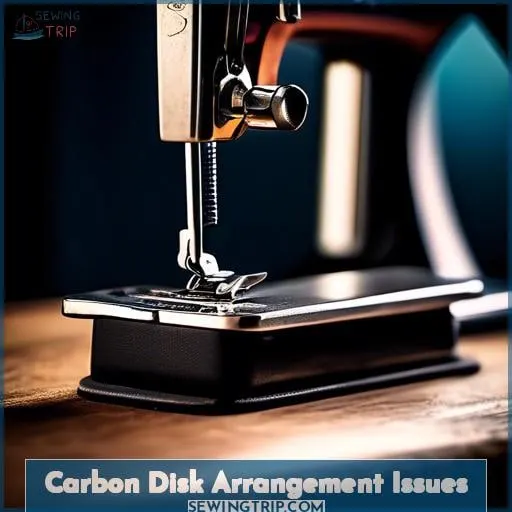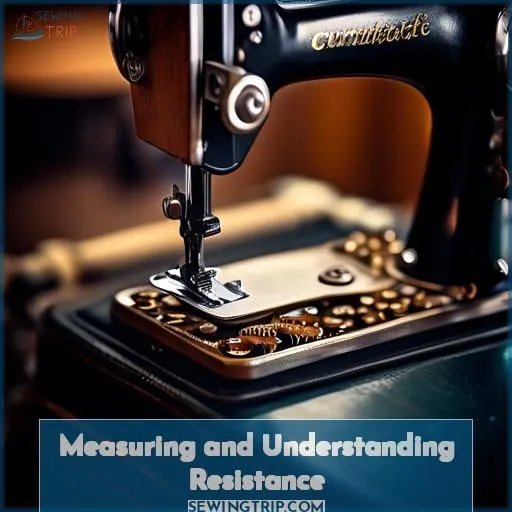This site is supported by our readers. We may earn a commission, at no cost to you, if you purchase through links.
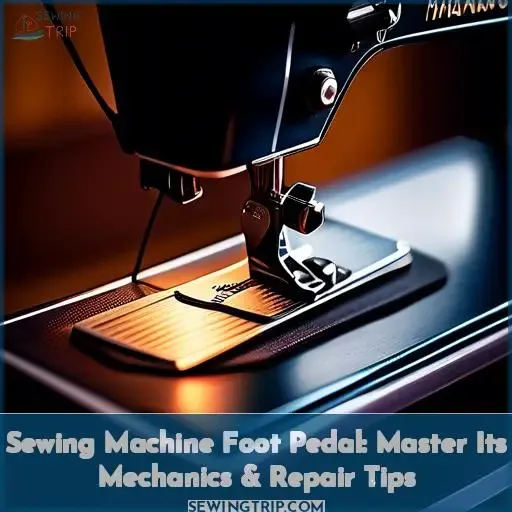 Slow and steady wins the race, they say, and when it comes to mastering your sewing machine foot pedal, this adage couldn’t be truer.
Slow and steady wins the race, they say, and when it comes to mastering your sewing machine foot pedal, this adage couldn’t be truer.
You’re in control, guiding the flow of electricity with each press, adjusting resistance to regulate speed.
Whether you’re troubleshooting a carbon disk hiccup or fine-tuning resistance for seamless operation, understanding the mechanics is key.
Dive into the intricacies of your foot pedal and equip yourself with repair tips to keep your sewing smooth and uninterrupted.
Table Of Contents
Key Takeaways
- Vintage Singer sewing machine foot pedals use a carbon disk and nipple assembly to regulate the flow of electricity, which in turn controls the machine’s speed.
- The resistance provided by the carbon disk assembly changes as the pedal is depressed, allowing for precise speed control, with higher resistance at a light press and lower resistance when fully depressed.
- Malfunctions in the foot pedal, such as erratic resistance changes or complete failure, can often be resolved by replacing carbon disks, adjusting spring contacts, or ensuring proper assembly and compatibility with the sewing machine.
- Regular maintenance, such as cleaning and lubrication, is important to prevent malfunctions caused by issues like worn-out springy metal contacts or incorrect carbon disk arrangements.
Sewing Machine Foot Pedal How It Works
A sewing machine foot pedal uses a rheostat to control the speed of the machine. The greater the pressure applied to the pedal, the faster the machine will sew.
Pedal Design and Functionality
The unique design of a vintage Singer sewing machine foot pedal incorporates multiple carbon disks and a nipple piece to regulate electricity flow and resistance.
This setup allows for precise control over the sewing machine’s speed, with resistance changing as the pedal is depressed.
Understanding this mechanism is crucial for troubleshooting and maintaining the pedal’s functionality, especially when facing issues like resistance anomalies or malfunction symptoms.
Unique Carbon Disk and Nipple Design
Your vintage Singer sewing machine foot pedal, with its unique carbon disk and nipple design, is a marvel of early electrical engineering. This design allows for the regulation of electrical resistance, and thus the sewing machine’s speed, through physical pressure applied by your foot.
- Carbon piece variation: The pedal contains multiple carbon disks. These disks, made from graphite, vary slightly in thickness and are critical for adjusting the pedal’s resistance. Their arrangement affects the pedal’s functionality, and incorrect assembly can lead to malfunctions.
- Springy metal stiffness: A springy metal contact, which changes its contact area with the nipple piece based on how much pressure you apply, plays a crucial role. This mechanism is designed to adjust the electrical resistance, but wear and tear can affect its performance.
- Nipple piece wear: Over time, the nipple piece that interacts with the carbon disks can wear down. This wear can alter the electrical contact quality, potentially leading to erratic resistance changes or even failure.
- Contact surface oxidation: The metal contacts within the pedal, including those that interact with the carbon disks and the nipple piece, can oxidize over time. This oxidation can increase electrical resistance unnecessarily, leading to poor performance or malfunction.
Understanding these components and their interactions is key to mastering your sewing machine foot pedal. Whether you’re troubleshooting an electronic fault or simply curious about how your pedal works, these insights provide a solid foundation.
Remember, a well-maintained pedal can significantly enhance your sewing experience on vintage machines.
Electricity Flow and Resistance Regulation
You’re dealing with a classic case of resistance regulation in your vintage Singer sewing machine foot pedal. The heart of the system is the carbon disk assembly, which, when pressed, changes the resistance and thus controls the speed of your sewing machine.
It’s like a dance between your foot and the pedal, where the pressure dictates the rhythm of the stitches.
Now, let’s break down the resistance troubleshooting process with a table that might resonate with your inner mechanic:
| Stage | Symptom | Action |
|---|---|---|
| Light Press | High Resistance (MOhms) | Check continuity, ensure proper carbon disk contact |
| Moderate Press | Variable Resistance (kOhms) | Inspect spring contact for even pressure distribution |
| Full Depression | Low Resistance (~1 Ohm) | Confirm shorting mechanism functions correctly |
| Malfunction | Resistance Erratic | Revisit assembly, consider graphite material degradation |
Keep in mind the power rating of the pedal and the importance of a correct wiring diagram. Without them, you’re navigating through a storm without a compass. So, grab your multimeter and let’s get that pedal back to smoothly orchestrating your sewing machine’s power, stitch by stitch.
Full Pedal Depression and Shorting Electrodes
When you’re dealing with a vintage Singer sewing machine foot pedal, you’re in for a bit of a nostalgic challenge.
- Carbon Piece Replacement: If your pedal’s acting up, swapping out those carbon disks might just do the trick.
- Assembly Error Detection: Make sure those disks are stacked correctly; an assembly mishap can cause quite the headache.
- Pedal Compatibility Verification: Not all pedals play nice with all machines. Double-check that they’re a match made in sewing heaven.
- Spring Contact Adjustment: A finicky spring contact can be the culprit behind erratic speeds, so give it a good tweak.
Resistance Regulation Mechanism
Understanding the resistance regulation mechanism in a sewing machine foot pedal is crucial for both operation and troubleshooting.
The pedal’s design allows for the variation of electrical resistance through the contact area between a springy metal and carbon disks, which directly affects the sewing machine’s speed.
This system can exhibit a wide range of resistance during normal operation, from kilohms to as low as 29 ohms when fully functional, and can even short to approximately 1 ohm at full pedal depression.
Malfunctions, however, may present as resistance anomalies, where the pedal resistance could unexpectedly sit at megaohms regardless of pedal pressure or fluctuate unpredictably, indicating potential issues with the springy metal contact or the arrangement of the carbon pieces.
Contact Area Variation With Springy Metal
As you dive into the world of sewing machine foot pedals, you’ll find the springy metal design is key to mastering the subtle dance of resistance regulation. Imagine the springy metal as a skilled ballroom dancer, gracefully altering its embrace with the carbon disk material, each movement changing the resistance and thus the speed of your sewing machine.
It’s a delicate tango between contact surface friction and electrical flow, where the right amount of pressure is paramount.
Now, let’s break down the resistance regulation mechanism into a bite-sized table:
| Factor | Impact |
|---|---|
| Carbon Disk Material | Determines the resistance and durability |
| Springy Metal Design | Adjusts contact area and pressure |
| Contact Surface Friction | Affects the smoothness of resistance changes |
| Cleaning Methods | Essential for maintaining consistent performance |
| Lubrication Benefits | Reduces wear and ensures longevity |
Resistance Range During Operation
When you’re at the helm of your vintage sewing machine, the resistance range is your sea, and you’re the captain navigating through the stormy waters of malfunction symptoms and machine issues.
- Resistance range: It’s like a light dimmer for your sewing machine, smoothly transitioning from a high-resistance kOhm sea to the low-resistance 29 ohm harbor.
- Malfunction symptoms: If you’re adrift in MOhm waters, it’s a sign of trouble; your sewing machine is crying out for help.
- Pedal compatibility: Ensure your pedal is the right mate for your sewing machine’s universal motors, or you might end up marooned.
- Safety precautions: Like a thermal fuse in an electrical circuit, always protect yourself and your machine from potential hazards.
Malfunction Symptoms and Resistance Anomalies
When your sewing machine foot pedal starts acting up, showing resistance anomalies or malfunction symptoms, it’s like trying to drive a car with a sticky gas pedal – frustrating and unpredictable. If your pedal’s resistance jumps from kilohms to a mere 29 ohms during operation or stubbornly sits at megohms regardless of how hard you press, you’re dealing with a classic case of pedal mood swings.
These fluctuations can be due to issues with the pedal’s springy metal contact not cozying up properly to the carbon disks or a potential assembly hiccup with those same disks.
Imagine trying to fine-tune a radio with a dial that jumps frequencies; that’s your pedal sensitivity going haywire. Durability concerns arise when the pedal decides to camp at high resistance levels, hinting at possible attachment or port issues.
If troubleshooting doesn’t smooth things over, exploring replacement options or considering an upgrade might be your next adventure. Remember, a well-behaved pedal should glide through resistance changes like a hot knife through butter, not play a game of resistance roulette.
Carbon Disk Arrangement Issues
When dealing with the carbon disk arrangement in your vintage Singer sewing machine’s foot pedal, it’s crucial to ensure the disks are correctly ordered by thickness and direction.
If you’ve reassembled the pedal without resolving the issue, it’s possible that the problem lies elsewhere, such as with the springy metal contact or the overall arrangement of the carbon pieces.
Importance of Correct Disk Thickness and Assembly
Understanding the correct disk thickness and assembly order in your sewing machine foot pedal’s carbon arrangement is crucial for optimal performance.
-
Disk Thickness: Each carbon disk’s thickness impacts the overall resistance of the pedal. A variance as slight as 0.1mm can significantly alter the pedal’s responsiveness and control over the sewing machine’s speed.
-
Assembly Order: The sequence in which you stack the carbon disks affects the electrical flow and, consequently, the pedal’s functionality. Incorrect assembly can lead to erratic resistance variation, causing the machine to either run uncontrollably fast or not at all.
-
Contact Spring: The springy metal contact’s interaction with the carbon disks is vital. It adjusts the contact area with the nipple pieces, influencing the resistance. If the assembly isn’t spot on, you might find your pedal stuck at MOhms or, conversely, shorting at full depression.
Troubleshooting Assembly Errors
After understanding the importance of carbon disk thickness, let’s dive into fixing assembly errors. If your pedal’s acting up, it’s likely due to carbon disk variation or assembly orientation mishaps.
Reassembling with an eye on carbon piece arrangement and contact springiness can work wonders.
| Issue | Check | Solution |
|---|---|---|
| Variation | Disk size | Sort by thickness |
| Orientation | Assembly direction | Follow manual |
| Impact | Reassembly | Test functionality |
| Springiness | Contact pressure | Adjust as needed |
Impact on Pedal Functionality
When troubleshooting your sewing machine foot pedal, remember that the devil’s in the details. The carbon composition and precise assembly impact pedal functionality more than you might think.
If the resistance variation is more roller coaster than smooth ride, you’ve got a problem. It’s not just about cleaning and reassembling; it’s about ensuring each carbon disk is in harmony with its neighbors.
And don’t overlook the microprocessor’s involvement; it’s the brain of the operation. If you’re hitting a wall, it might be time to play detective with the springy metal contact and carbon arrangement.
Keep your cool, and you’ll stitch up the issue in no time.
Measuring and Understanding Resistance
To grasp the workings of your sewing machine foot pedal, it’s crucial to measure and understand its resistance.
By directly measuring resistance from the wire contact points and comparing these readings with those of similar vintage pedals, you’ll identify whether your pedal operates within the expected range or exhibits fluctuations indicative of malfunction.
Direct Measurement From Wire Contact Points
When tackling the challenge of measuring resistance directly from the wire contact points in your vintage Singer sewing machine pedal, you’re diving into a world where precision meets patience. Remember, it’s all about the connection—just like in a good conversation. Think of each carbon disk as a participant in this electrical dialogue, with the thickness of each disk and the assembly order playing crucial roles in how smoothly the conversation flows.
Incorrect assembly or variations in carbon disk thickness can be like miscommunications that lead to resistance changes, sometimes leaving you chatting in megaohms when you were aiming for a cozy 29 ohms.
If you find yourself scratching your head, wondering why your pedal is acting more like a moody teenager than a reliable tool, it’s time to double-check those wire connections and carbon disk assembly.
A misstep here could be the root of your woes. And remember, while it might feel like you’re trying to solve a puzzle in the dark, the light at the end of the tunnel comes from understanding that these components—no matter how small—play a massive role in the pedal’s functionality.
So, grab your tools, and let’s ensure those wires are as conductive as a lively debate and the carbon disks are arranged like a well-orchestrated symphony.
Comparison With Similar Vintage Pedals
Continuing from where you’ve measured resistance directly from your pedal’s wire contact points, let’s compare your findings with similar vintage pedals.
- Compatibility: Ensure the resistance range matches that of your sewing machine’s specifications to avoid overheating or malfunction.
- Power Tools: If you’re considering pedal modification for power tools, remember that safety measures are paramount.
- Microprocessor Control: Modern pedals may include microprocessor control, which could affect functionality when retrofitting to vintage machines.
Resistance Fluctuations and Stable Operation Indicators
Continuing from the comparison with similar vintage pedals, let’s delve into the resistance fluctuations and stable operation indicators of your sewing machine foot pedal. When your pedal is on the fritz, showing resistance all over the map, it’s like trying to hit a moving target blindfolded—not exactly a recipe for a relaxing sewing session.
But when it’s humming along at a steady 29 ohms, you know you’ve hit the sweet spot, and it’s smooth sailing from there.
Here’s a quick table to help you visualize the resistance ranges you might encounter and what they could mean:
| Resistance Range | Status Indicator | Possible Action |
|---|---|---|
| MOhms | Malfunctioning | Check carbon disk arrangement |
| kOhms | Unstable | Clean contacts, reassess assembly |
| ~100-200 Ohms | Normal (Other Pedals) | Compare functionality |
| ~29 Ohms | Working Properly | Maintain current setup |
Troubleshooting and Repair Tips
When troubleshooting a vintage Singer sewing machine foot pedal, it’s crucial to start with the basics: ensure the contacts are clean and the wires are conducting properly.
If the pedal’s resistance fluctuates or remains unusually high, the issue might lie within the springy metal contact or the arrangement of the graphite carbon disks. These components are essential for the pedal’s functionality, as they regulate the electrical flow and resistance, directly impacting the sewing machine’s speed.
A meticulous examination and adjustment of these parts can often resolve common malfunctions, restoring smooth operation to your vintage Singer sewing machine.
Cleaning Contacts and Checking Wire Conductivity
When tackling the finicky nature of your sewing machine foot pedal, remember that the devil is in the details.
After measuring resistance and finding those pesky anomalies, it’s time to roll up your sleeves. Start by giving those carbon disk contacts a good scrub; think of it as dental hygiene for your machine.
A clean contact is a happy contact, and it’s crucial for maintaining wire conductivity.
If the springy metal contact is acting up, it might just need a little TLC. A bit of elbow grease and a keen eye can go a long way in getting your pedal back in tip-top shape.
Keep in mind, if the resistance is still jumping to the moon and back, you might be dealing with a deeper issue in the carbon disk arrangement.
Graphite Carbon Disks Maintenance
Maintaining your sewing machine’s foot pedal, especially those vintage models with graphite carbon disks, is like tending to a delicate garden.
- Graphite Conductivity: Ensure each disk is clean to maintain optimal conductivity. A soft pencil eraser works wonders for gently removing any carbon buildup without damaging the disks.
- Carbon Thickness and Assembly Orientation: Pay close attention to the thickness and order of the carbon disks. Even a minor mix-up in assembly can lead to significant performance issues. Remember, the devil’s in the details.
- Spring Tension and Contact Oxidation: Regularly check the spring for proper tension and the contacts for any signs of oxidation. A bit of electronic cleaner can go a long way in preventing unwanted resistance changes.
Just like a well-oiled machine, a bit of TLC can keep your pedal—and your sewing projects—moving smoothly.
Potential Springy Metal Contact and Carbon Arrangement Problems
After diving into the world of graphite carbon disks, let’s tackle the nitty-gritty of springy metal contacts and carbon disk alignment.
Think of your pedal as a finicky eater; it’s not just about what’s on the plate but how it’s arranged. If your carbon disks are playing musical chairs, your pedal’s performance will be as unpredictable as a cat on a hot tin roof.
Ensure those disks are lined up like soldiers—thickness matters, and a 0.1mm difference can throw a wrench in the works.
Don’t forget about spring tension adjustment; too loose or too tight, and you’re in for a bumpy ride.
Frequently Asked Questions (FAQs)
Can pedals be modified for hand use?
You can indeed tweak pedals for hand use; it’s a nifty fix for those who can’t foot it.
Are sewing machine pedals interchangeable?
Sewing machine pedals are like keys to a kingdom, unlocking the power of your machine with a gentle press.
However, they’re not universally interchangeable. Compatibility hinges on the model and brand, as well as the pedal’s power rating and connector type.
It’s a dance of precision, where using the wrong partner could lead to a misstep in your sewing project.
Always check your machine’s manual or consult with a professional to ensure a harmonious match, keeping your sewing journey smooth and your creations flawless.
How do pedals affect machine longevity?
Using a pedal that’s not properly matched to your machine can lead to overheating or underperformance, potentially shortening its lifespan.
It’s like driving a car with the wrong gear; it won’t end well!
Can pedals be used with other appliances?
Using a sewing machine foot pedal with other appliances is like trying to fit a square peg in a round hole; it might work, but it’s not what it’s made for.
Pedals are designed specifically for sewing machines, and while they can control speed, using them with other appliances could lead to overheating or failure due to mismatched power ratings.
Always check compatibility and safety first.
Do all sewing machines require a pedal?
No, not all sewing machines require a pedal.
Many modern machines, especially computerized ones, offer alternatives like start/stop buttons, allowing for pedal-free operation.
Conclusion
As the saying goes, A stitch in time saves nine, mastering your sewing machine foot pedal is essential for precision and efficiency.
By understanding the pedal’s design, resistance regulation, and carbon disk issues, you’re equipped to tackle any hiccups.
With these insights on how a sewing machine foot pedal works, you’re set to keep your projects running seamlessly, stitch by stitch.

